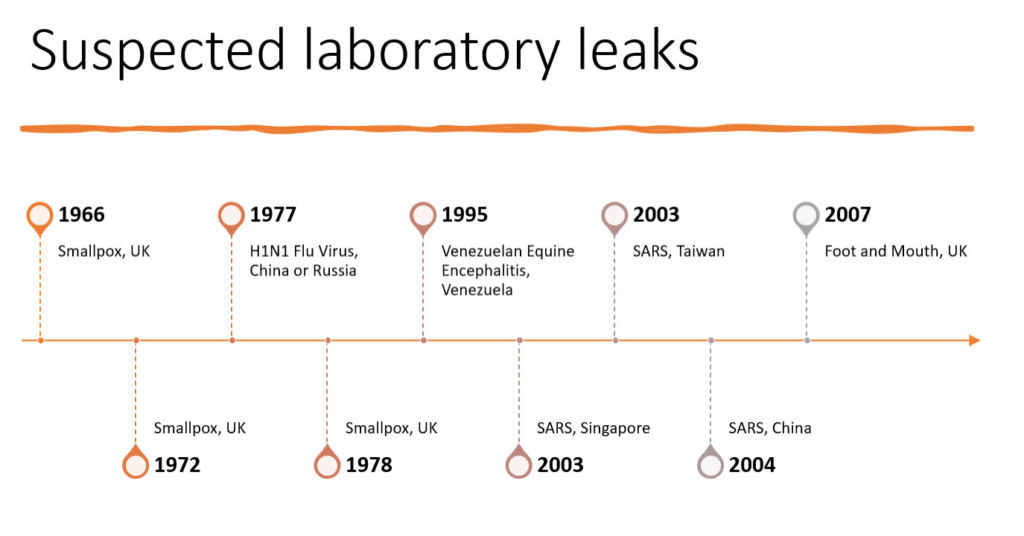Using scenarios for more accurate forecasts in uncertain or complex situations is an essential part of the security and intelligence practitioners’ toolkit. They map out the most likely future trajectories of a situation, helping to interpret risks, avoid bias, and provide indicators that can be tracked to aid decision making. While scenarios should always be credible, they can be instrumental in identifying and tracking outcomes that are of a lower probability but have higher impacts. Tracking these types of scenarios helps to ensure we are prepared for extreme outcomes.
In May 2021, U.S. President Joe Biden asked the U.S. intelligence community to “redouble their efforts” in identifying a definitive conclusion to the origin of the COVID-19 pandemic. With the report due towards the end of August, the origin of the COVID-19 pandemic provides an interesting scenario example to work with.
The World Health Organization declared COVID-19 a global pandemic on March 11, 2020. Over 18 months later, its origin is yet to be determined. The most common view is that the virus jumped from one animal to an intermediary host, then to humans – most emerging infectious diseases begin this way.
In previous similar cases such as the Severe Acute Respiratory Syndrome (SARS) epidemic in 2002 and the Middle East Respiratory Syndrome (MERS) epidemic in 2012, the intermediary host species for the causative viruses were discovered relatively quickly. For example, civet cats were found to be associated with SARS-CoV within four months, and camels were identified as the intermediary for MERS within nine months.
This lack of a confirmed natural origin for COVID-19 has strengthened the opinion that another plausible scenario for the cause of the pandemic is an accidental leak from the Wuhan Institute of Virology, where research into coronaviruses was known to have taken place. However, the accidental leak hypothesis is hotly disputed, and identifying the origins of disease outbreaks is no easy undertaking.
While the intermediary host species for SARS-CoV was identified in months, it took nearly 15 years to trace it back to bats. The lack of an identified natural origin does not, therefore, make the laboratory leak theory more probable, but the potential geopolitical and security implications of it becoming a prevalent narrative necessitates assessing the approximate likelihoods and implications of each of the prevailing scenarios for the emergence of SARS-CoV-2 which subsequently led to the COVID-19 pandemic.
There are three dominant scenarios:
Scenario 1. Zoonotic A: From an animal to humans via an intermediate animal host. This scenario is considered the most likely and has the most historical precedent. For example, the virus could have jumped from one species, such as a bat, to another animal, then to humans. This is currently thought to be the most likely scenario.
Scenario 2. Zoonotic B: Direct from animal, again most likely a bat, to humans. This is not considered the most likely scenario, but evidence exists for this having occurred before and it, therefore, remains a credible possibility.
Scenario 3. Accidental Laboratory Leak: The virus leaked from the Wuhan Institute of Virology most likely accidentally. This is currently considered a low probability scenario, but disease outbreaks caused by laboratory leaks have occurred previously.

Scenario 1 and Scenario 2 have lesser geopolitical and security repercussions. If either is confirmed there will be greater pressure from environmental groups, activists, and others for humans not to encroach on wildlife. There will also be increased pressure on China for more stringent regulations of its animal trade particularly at wet markets. Additionally, there will be calls for more global cooperation and greater transparency on disease surveillance. The anti-China sentiment which has increased and led to the physical assault of individuals of east-Asian appearance will persist.
The third scenario, an accidental leak, is likely to have the greatest impacts. What these will be is dependent on how convincing the evidence is. China is very unlikely to admit that a leak occurred. Evidence will have to come through independent investigations and academic research, as well as whistle-blowers.
Nevertheless, if the laboratory leak becomes the mainstream opinion then impacts are likely to include civil unrest, heightened geopolitical tension between the west and China, stock market volatility, increased anti-China and possibly anti-U.S. sentiment (the U.S. is known to have funded research at the Wuhan Institute of Virology). Multiple countries might also call for sanctions on China, or for China to pay reparations because of the economic damage caused by the pandemic.
Even if it is not confirmed, the release of academic papers and investigations into the lab leak theory will embolden conspiracy theorists and drive further narratives which will increase the risk to virologists (similar to the case in Belgium), as well as organizations involved in vaccine development, logistics, and infrastructure, and organizations and individuals engaged in viral research.
Despite media speculation about the lab leak hypothesis, it remains a low probability scenario, however, its impacts are potentially very high. Many were surprised by the pandemic, which we knew to be a credible scenario, failing to track and plan for it adequately. Highlighting the need to carry out scenario development and monitoring.
Tracking risk situations that impact an organization can be daunting. Ascertaining the key scenarios effecting your company, defining the “so what” to each, and then laying out triggers, indicators and signposts is a critical piece to any risk monitoring program. AT-RISK International is prepared to provide supporting exercises to assist in building and maintaining an intelligence driven, operations led, and threat informed strategy.
For more information and/or to discuss your unique security and risk mitigation needs, please contact a member of the AT-RISK International team.
By Ross Hill and Nickolas Allen





